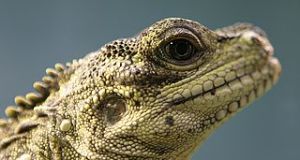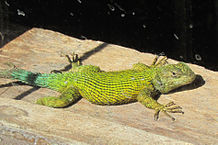Please see Part I of this article for more on bent-toed geckos (Genus Cyrtodactylus; C. louisiadensis and C. irianjayaensis).
UVB and Calcium
 Although nocturnal, assume that bent-toed geckos require UVB radiation (others in the genus seem prone to metabolic bone disease). As these lizards generally do not bask at very high temperatures, a fluorescent bulb is preferable. Among florescent models, the Zoo Med 10.0 Bulb has been shown to consistently deliver the highest UVB output.
Although nocturnal, assume that bent-toed geckos require UVB radiation (others in the genus seem prone to metabolic bone disease). As these lizards generally do not bask at very high temperatures, a fluorescent bulb is preferable. Among florescent models, the Zoo Med 10.0 Bulb has been shown to consistently deliver the highest UVB output.
To cover all bases until we learn more, I suggest adding extra calcium (along with Vitamin D3) to all food offered. A high calcium supplement can easily be fashioned by mixing Reptivite and Zoo Med Repti Calcium together in a 1:1 ratio. While this step has not specifically been proven necessary, it has served me well in similar situations.
Snails as a Calcium Source
Many arboreal geckos, Cyrtodactylus included, relish snails, and these seem to be an important source of calcium in the wild.
You can use small garden or aquarium snails, or smaller individuals of those species typically sold for human consumption (i.e. the grapevine snail, Helix pomatia). All can be rather easily reared at home, with the aquatic species being, in general, more prolific.
If you would like to raise your own snails, I suggest the large freshwater snails commonly sold as apple snails in pet stores. They are quite interesting in their own right, so don’t be surprised if you wind up paying them quite a bit of attention! Apple snails lay orange egg cases just above the water line; these are produced year-round, with more being laid as food intake increases. Apple snails feed ravenously, and do well on a diet of Spirulina disks and kale, romaine and other greens. They should also be provided with a piece of cuttlebone (discard the metal holder provided for use with cage birds) as a calcium source. The young fall into the water upon hatching and grow rapidly.
Any of the small aquatic snails commonly found among aquarium plants can be bred and used as a food source as well.
Most terrestrial snails do not breed quite as rapidly as do apple snails, and temperate species need a cool period (a refrigerator works well) of 2-4 weeks at 38-40 F if they are to reproduce. Most feed readily upon tropical fish flakes, fruit, vegetables and cuttlebone.
Diet
Roaches stimulate most geckos to feed; many also respond with enthusiasm to moths, beetles and other wild caught insects. Please see my article on Raising Orange-Spotted Roaches for more information.
I believe it to be very important to offer a variety of invertebrates to bent-toed geckos. If at all possible, try to collect local insects…the Zoo Med Bug Napper is very useful to have on hand.
Leave food in the terrarium overnight, and offer grubs, mealworms, wax worms and the like in cups suspended above ground as opposed to releasing them in the terrarium.
Further Reading
Providing reptiles with a varied diet is always important, but never more so than when dealing with bent-toed geckos and other little-studied species. Please see my article Collecting Live food for Reptiles and Amphibians for some tips on providing your lizard with wild-caught invertebrates.
Image referenced from Wikipedia and originally posted by W.A. Djatmiko. Image is NOT the Giant Bent-toed Gecko, but a related species, Cyrtodactylus marmoratus.
 That Reptile Blog – Reptile, Amphibian and Exotic Pet Care and Information
That Reptile Blog – Reptile, Amphibian and Exotic Pet Care and Information



